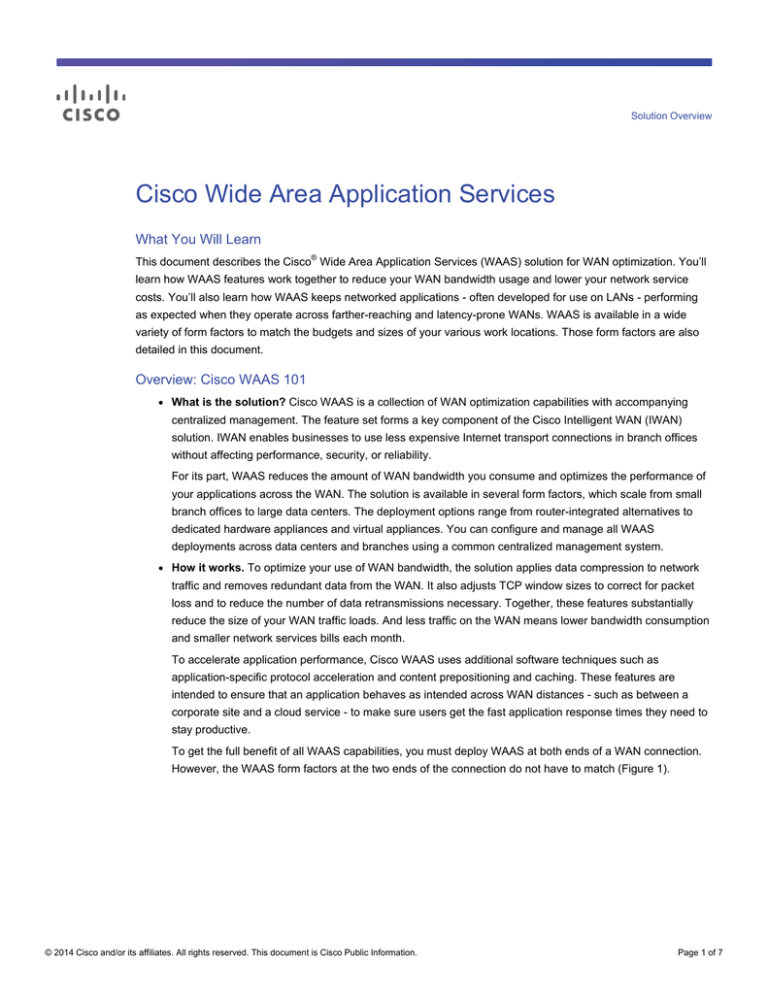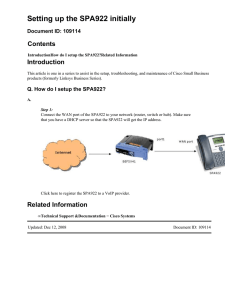
Solution Overview
Cisco Wide Area Application Services
What You Will Learn
This document describes the Cisco® Wide Area Application Services (WAAS) solution for WAN optimization. You’ll
learn how WAAS features work together to reduce your WAN bandwidth usage and lower your network service
costs. You’ll also learn how WAAS keeps networked applications - often developed for use on LANs - performing
as expected when they operate across farther-reaching and latency-prone WANs. WAAS is available in a wide
variety of form factors to match the budgets and sizes of your various work locations. Those form factors are also
detailed in this document.
Overview: Cisco WAAS 101
●
What is the solution? Cisco WAAS is a collection of WAN optimization capabilities with accompanying
centralized management. The feature set forms a key component of the Cisco Intelligent WAN (IWAN)
solution. IWAN enables businesses to use less expensive Internet transport connections in branch offices
without affecting performance, security, or reliability.
For its part, WAAS reduces the amount of WAN bandwidth you consume and optimizes the performance of
your applications across the WAN. The solution is available in several form factors, which scale from small
branch offices to large data centers. The deployment options range from router-integrated alternatives to
dedicated hardware appliances and virtual appliances. You can configure and manage all WAAS
deployments across data centers and branches using a common centralized management system.
●
How it works. To optimize your use of WAN bandwidth, the solution applies data compression to network
traffic and removes redundant data from the WAN. It also adjusts TCP window sizes to correct for packet
loss and to reduce the number of data retransmissions necessary. Together, these features substantially
reduce the size of your WAN traffic loads. And less traffic on the WAN means lower bandwidth consumption
and smaller network services bills each month.
To accelerate application performance, Cisco WAAS uses additional software techniques such as
application-specific protocol acceleration and content prepositioning and caching. These features are
intended to ensure that an application behaves as intended across WAN distances - such as between a
corporate site and a cloud service - to make sure users get the fast application response times they need to
stay productive.
To get the full benefit of all WAAS capabilities, you must deploy WAAS at both ends of a WAN connection.
However, the WAAS form factors at the two ends of the connection do not have to match (Figure 1).
© 2014 Cisco and/or its affiliates. All rights reserved. This document is Cisco Public Information.
Page 1 of 7
Figure 1.
●
Lots of WAAS Deployment Options
Business value. There are two main reasons organizations find value in WAAS. First, WAN bandwidth
represents a significant portion of network operating expenses. That’s because WAN usage is escalating,
as users increasingly access both cloud services and their corporate data centers from remote and mobile
locations. They’re also regularly using video, collaboration, virtual desktops, and other apps that consume
very large volumes of network capacity. WAAS pares down the capacity these apps consume, however,
using compression, de-duplication, and other efficiency techniques. As a result, many enterprises can move
ahead with these applications but defer investments in additional WAN bandwidth. In effect, Cisco WAAS
lets you squeeze the most out of the capacity you already have. That’s money in the bank.
WAAS’s other primary strength is in network application performance. The geographically long reach of the
WAN introduces distance-based latency, often accompanied by jitter and packet loss, into data
transmissions. If left unmanaged, these factors can degrade users’ application experiences, especially with
real-time apps that are sensitive to delays. In a domino effect, unsatisfying app experiences decrease users’
acceptance of the apps, which lowers their productivity and, ultimately, impacts your business. In fact, poor
application response time experienced by users in remote sites is often cited as one of the main inhibitors to
cloud adoption. The WAAS solution helps counteract these negative application experiences with
sophisticated acceleration techniques.
© 2014 Cisco and/or its affiliates. All rights reserved. This document is Cisco Public Information.
Page 2 of 7
Solution Components
Cisco WAAS core features span bandwidth optimization and application acceleration functions. They are detailed
in Table 1. In addition, you can license optional, add-on WAAS capabilities to further improve your WAN usage and
performance and to centrally manage your distributed WAAS deployments. These capabilities are listed in the table
in the “WAAS Add-On Components” section of Table 1.
Table 1.
Cisco WAAS Components and Benefits
WAN Optimization Feature
Description
TCP flow optimization (TFO)
Improves application packet flow under unfavorable
WAN conditions such as during packet loss and small
initial windows while helping ensure fairness.
Benefit(s)
● Maintains consistent network
performance and application session
quality.
Context-aware data redundancy
elimination (DRE)
Identifies previously seen TCP traffic and replaces
redundant patterns with very small signatures.
Provides up to 100:1 compression depending on the
data being examined for dramatically reduced WAN
traffic loads.
● Reduces your WAN traffic loads and
associated monthly services bill.
● Saves money by helping you to avoid or
postpone new bandwidth investments.
Adaptive persistent session-based
Lempel-Ziv (LZ) compression
Provides up to an additional 5:1 compression on top of
DRE (see previous entry) for further WAN traffic
reduction.
● Reduces your WAN traffic loads and
associated monthly services bill.
● Saves money by helping you to avoid or
postpone new bandwidth investments.
Per-application optimization
Application-specific acceleration is available for
Microsoft Windows file sharing (Common Internet File
System [CIFS]); Microsoft Exchange (Messaging API
[MAPI] and MAPI over SSL); encrypted MAPI
[EMAPI], HTTP, and HTTPS applications such as
Oracle, SAP, and Microsoft SharePoint and Outlook
Web Access (OWA); Microsoft Windows print
services; UNIX Network File System (NFS); and Citrix
ICA.
● Helps ensure that much-used business
apps initially designed to operate on
faster, shorter-distance LANs continue to
perform as expected across slower and
longer-distance WANs.
WAAS Add-On Component
Description
AppNav
Creates a pool of virtual WAAS resources out of all
your physical WAAS service deployments. This way,
WAAS traffic can be “load balanced” across available
WAAS resources for optimum use.
Benefit(s)
● Allows for easy scalability as traffic loads
increase.
● Delivers persistent uptime and WAAS
resource availability.
AppNav is available as a standalone hardware
appliance, as a module for WAAS appliances, and as
integrated software for Cisco 4451-X Integrated
Services Routers (ISRs) and Cisco ASR 1000 Series
Aggregation Services Routers (ASRs).
Cisco IWAN with Akamai Connect
Performs HTTP (Internet) content caching and
prepositioning to make rich-media content from the
web available on demand with high quality. The
caching intelligence from Cisco partner Akamai comes
embedded in Cisco ISRs and Cisco Wide Area
Virtualization Engine (WAVE) appliances.
● Provides a boost to performance of all
business and web applications, including
point of sale (POS), HD video, digital
signage, and in-store online ordering.
How the Solution Is Packaged for Purchase
●
WAAS Core Functions
There are two Cisco WAAS packages of core functions that you may purchase:
1.
Traditional Cisco WAAS, which contains all the core WAN optimization and application acceleration
features described in Table 1. The full package of features is available in a wide variety of form factors,
detailed in the next section.
2.
Cisco WAAS Express (WAASx), which contains a subset of traditional Cisco WAAS components.
Targeted at smaller sites, Cisco WAASx is integrated natively into Cisco IOS Software on Cisco 800,
1900, 2900, and 3900 Series ISRs. WAASx supports data compression and TCP acceleration.
© 2014 Cisco and/or its affiliates. All rights reserved. This document is Cisco Public Information.
Page 3 of 7
●
WAAS Management
Cisco WAAS Central Manager is an add-on to core WAAS features, sold separately. Cisco WAAS Central
Manager is required to manage your WAAS installation.
Workflow-based WAAS Central Manager manages configuration, provisioning, fault management, logging,
and customized reporting. It can create scheduled reports for Cisco WAAS devices and ISRs running Cisco
WAASx. User-friendly HTML5 interfaces provide detailed visibility into application performance, passthrough traffic, and the control and monitoring of specific context-aware devices, including clusters. You can
run the management system directly on Cisco WAAS appliances or as a virtual server, called Cisco vWAAS
Central Manager (vCM).
Form Factors
After you decide what set of WAAS functions you require, you can choose from the many form factors described as
follows. Consider how large the site is and how many concurrent users and traffic flows are typical when choosing
your deployment options:
●
Router-integrated form factors (3):
1.
Integrated directly into the Cisco IOS XE Software image of Cisco 4451-X ISRs. You launch WAAS on
this platform using EZConfig, a single command-line interface (CLI) command that makes initial
provisioning simple, quick, and easy
2.
Plug-in WAAS modules for certain Cisco ISR models
3.
Integrated directly into the Cisco IOS Software image of Cisco ISR Generation 2 routers (WAASx
functions only)
●
An appliance form factor called Cisco Wide Area Virtual Engine (WAVE). This is the most powerful
option in terms of WAAS throughput. Note that the Cisco WAVE appliance can alternatively be deployed as
a WAAS Central Manager node. WAVE can function in either full WAAS appliance mode or in full WAAS
Central Manager mode; it cannot perform both roles concurrently.
●
A virtual appliance called vWAAS, which is software that can run on Cisco ISR Services-Ready Engine
(SRE) and Unified Computing System E-Series Server modules or on x86 servers
Tables 2 through 8 summarize each form factor and its recommended location in the network.
Table 2.
Cisco WAVE Appliance Options
WAVE Platform
WAVE 294
WAVE 594
WAVE 694
WAVE 7541
WAVE 7571
WAVE 8541
Network Location
Small Branch
Office
Large Branch
Office or Campus
Large Branch
Office, Data
Center, or
Campus
Data Center or
Campus
Data Center or
Campus
Data Center or
Campus
Target WAN Bandwidth
(Mbps)
10-20
50-100
200
500
1,000
2,000
Number of Optimized
TCP Connections
Supported
200-400
750-1,300
2,500-6,000
18,000
60,000
150,000
Optimized LAN
Throughput (Mbps)
100-150
250-300
450-500
1,000
2,000
4,000
© 2014 Cisco and/or its affiliates. All rights reserved. This document is Cisco Public Information.
Page 4 of 7
Table 3.
ISR Services-Ready Engine (SRE) and Cisco UCS E-Series Server Blade Options
Module
SRE 710
SRE 910
UCS E-Series120
UCS E-Series
140/160/180
Network Location
Small to Medium-Sized
Branch Office
Medium-Sized to Large
Branch Office
Small to Medium-Sized
Branch Office
Medium-Sized to Large
Branch Office
Target WAN Bandwidth
(Mbps)
20
50
20-200
20-200 per WAAS
instance*
Number of Optimized
TCP Connections
500
1,000
200-2500
200-6,000 per WAAS
instance*
Optimized LAN
Throughput (Mbps)
200
300
100-400
100-400 per WAAS
instance*
*
It’s possible to run mxultiple vWAAS instances on each E-Series module, and multiple modules can run on each router for
greater WAAS density.
Table 4.
Cisco vWAAS Suite of Licenses
Cisco vWAAS License
vWAAS 200
vWAAS 750
vWAAS 1300
vWAAS 2500
vWAAS 6000
vWAAS 12000 vWAAS 50000
Network Location
Small Branch
Office, Data
Center, or
Campus
Small Branch
Office, Data
Center, or
Campus
Branch Office,
Data Center,
or Campus
Branch Office,
Data Center,
or Campus
Branch Office,
Data Center,
or Campus
Large Branch
Office, Data
Center, or
Campus
Large Branch
Office, Data
Center, or
Campus
WAN Bandwidth
(Mbps)
20
50
80
200
200
310
700
Number of Optimized
TCP Connections
Supported
200
750
1,300
2,500
6,000
12,000
50,000
Optimized LAN
Throughput (Mbps)
100
250
300
400
400
425
1,000
Table 5.
Cisco ISR Series Routers Supporting WAAS Express
Cisco ISR Platform
880
890
880 or 890
with 1-GB
DRAM
1921
1941
2901
2900 Series
(except 2901)
3900 Series
Network Location
Teleworker or
Small Branch
Office
Teleworker or
Small Branch
Office
Teleworker or
Small Branch
Office
Small
Branch
Office
Small
Branch
Office
Small
Branch
Office
Small-toMedium Sized
Branch Office
Large Branch
Office
Target WAN Bandwidth
(Mbps)
1.5
2
5
0.512
4
6
6
10
Number of Optimized
TCP Connections
75
75
125
50
150
150
200
400
Optimized LAN
Throughput (Mbps)
3
4
11
1
8
12
12
20
Table 6.
Cisco ISR Application Experience (AX) Series Routers
Cisco ISR Platform
1921-AX
1941-AX
2901-AX
2900-AX Series
(except 2901)
3900-AX Series
4400-AX Series
Network Location
Small Branch
Office
Small Branch
Office
Small Branch
Office
Small to MediumSized Branch Office
Large Branch Office
Large Branch Office
Target WAN Bandwidth
(Mbps)
0.512
4
6
6-200
10-200
10-200*
Number of Optimized
TCP Connections
50
150
150
200-6,000
200-6,000
200-6,000*
Optimized LAN
Throughput (Mbps)
1
8
12
12-400
12-400
12-400*
*
It’s possible to run multiple WAAS instances on each 4451 by adding additional UCS-E-Series modules.
© 2014 Cisco and/or its affiliates. All rights reserved. This document is Cisco Public Information.
Page 5 of 7
Table 7.
Cisco WAAS Central Manager
Cisco WAAS Model*
WAVE 294 with 4-GB DRAM
WAVE 594 with 8-GB DRAM
WAVE 694 with 16-GB DRAM
Number of Managed WAAS
Nodes
250
1000
2000
*
Central Manager licensing is included with each WAVE platform.
Table 8.
Cisco vWAAS Central Manager (vCM)
*
Cisco vCM License
vCM 100
vCM 2000
Number of Managed WAAS Nodes
100
2,000
*
Central Manager licensing is included with each WAVE platform. vCM licenses may be purchased separately and run on Cisco
UCS or other x86 server with VMWare ESXi.
Deployment Requirements and Options
Deploy WAAS on each side of the WAN connection to provide application-specific acceleration and WAN
optimization capabilities. Depending on your preference for management or network topology, you can deploy
Cisco WAAS appliances out of the data path or physically in-path in the data center or in the remote branch office.
You can deploy Cisco WAAS network modules as well as service modules out-of-path in the branch office.
Regardless of the deployment model, Cisco WAAS provides application performance improvements and enables
centralization without compromising high availability and scalability.
Service and Support
Cisco offers a wide range of services programs to accelerate customer success. These innovative services
programs are delivered through a unique combination of people, processes, tools, and partners, resulting in high
levels of customer satisfaction. Cisco Services offerings help you protect your network investment, optimize
network operations, and prepare your network for new applications to extend network intelligence and the power of
your business. For more information about Cisco Services, refer to Cisco Technical Support Services and Cisco
Advanced Services.
Why Turn to Cisco?
Cisco offers the greatest variety of WAN optimization form factors in the industry, including router-integrated
options. Thus customers have the flexibility to deploy WAN optimization where needed, on-demand, with the
lowest footprint in the industry.
As part of the Cisco Intelligent WAN solution, WAAS can help IT navigate today’s challenges around cloud,
mobility, and video. Cisco offers the most comprehensive solution at a cost-effective price with validated designs to
help ensure customer success.
For More Information
For more information, please visit http://www.cisco.com/go/waas or contact your local Cisco account
representative.
© 2014 Cisco and/or its affiliates. All rights reserved. This document is Cisco Public Information.
Page 6 of 7
Printed in USA
© 2014 Cisco and/or its affiliates. All rights reserved. This document is Cisco Public Information.
C22-732054-00
07/14
Page 7 of 7




